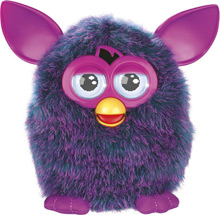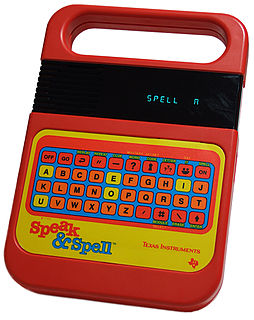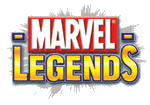
Furby is an American electronic robotic toy that was originally released in 1998 by Tiger Electronics. It resembles a hamster or owllike creature and went through a period of being a "must-have" toy following its holiday season launch, with continual sales until 2000. Over 40 million Furbies were sold during the three years of its original production, with 1.8 million sold in 1998, and 14 million in 1999. Its speaking capabilities were translated into 24 languages.

Mr. Potato Head is an American toy consisting of a plastic model of a potato "head" to which a variety of plastic parts can attach — typically ears, eyes, shoes, hat, nose, pants and mouth.
Kenner Products, known simply as Kenner, is a former American toy company founded in 1946. Throughout its history the Kenner brand produced several highly recognizable toys and merchandise lines including action figures like the original series of Star Wars, Jurassic Park and Batman as well as die cast models. The company was closed by its corporate parent Hasbro in 2000.

Care Bears are a group of multi-colored bears, originally painted in 1981 by artist Elena Kucharik to be used on greeting cards from American Greetings. In 1983, the characters were turned into plush teddy bears.
Popples is a toy and television franchise created by Those Characters From Cleveland (TCFC), a subsidiary of American Greetings. Popples resemble brightly colored marsupial teddy bears with long tails ending in a pom-pom. Each Popple character transforms to resemble a brightly colored ball. In 2018, Popples was sold to Hasbro.

Action Man is an action figure launched in Britain in 1966 by Palitoy as a licensed copy of Hasbro's American "movable fighting man", G.I. Joe.

The Texas Instruments LPC Speech Chips are a series of speech synthesizer digital signal processor integrated circuits created by Texas Instruments beginning in 1978. They continued to be developed and marketed for many years, though the speech department moved around several times within TI until finally dissolving in late 2001. The rights to the speech-specific subset of the MSP line, the last remaining line of TI speech products as of 2001, were sold to Sensory, Inc. in October 2001.

Teddy Ruxpin is an animatronic children's toy in the form of a talking 'Illiop', a creature which looks like a bear. The toy's mouth and eyes move while he reenacts stories played on an audio tape cassette deck built into its back. It was created by Ken Forsse with later assistance by Larry Larsen and John Davies, and the first version of the toy was designed by RKS Design. Later versions have a digital cartridge in place of a cassette. At the peak of its popularity, Teddy Ruxpin became the best-selling toy of 1985 and 1986, and the 2006 version was awarded the 2006 Animated Interactive Plush Toy of the Year award by Creative Child Magazine. A cartoon based on the characters debuted in 1986. Teddy's extreme popularity in 1986 buoyed the controversial launch of the Nintendo Entertainment System, also distributed by Worlds of Wonder.
In American radio, film, television, and video games, walla is a sound effect imitating the murmur of a crowd in the background. A group of actors brought together in the post-production stage of film production to create this murmur is known as a walla group. According to one story, walla received its name during the early days of radio, when it was discovered that having several people repeat the sound walla in the background was sufficient to mimic the indistinct chatter of a crowd. Nowadays, walla actors make use of real words and conversations, often improvised, tailored to the languages, speech patterns, and accents that might be expected of the crowd to be mimicked.

Marvel Legends is an action figure line based on the characters of Marvel Comics, initially produced by Toy Biz, then by Hasbro. This line is in the 6-inch (150 mm) scale, with spin-off lines in the 4-inch (100 mm), 8-inch (200 mm), and 12-inch (300 mm) scale.

The Adventures of Teddy Ruxpin is an American/Canadian animated television series based on Teddy Ruxpin, an animatronic teddy bear created by Ken Forsse and distributed by toy manufacturer Worlds of Wonder. It was produced for television syndication by DIC Enterprises with Atkinson Film-Arts using many of the same voice actors used in the book-and-tape series that was made for the eponymous animatronic toy. While some of the stories used in the TV series were adapted from the books, many were original and greatly expanded upon the world established there. The series differed from traditional children's animation in that most of its 65 episodes were serialized rather than in traditional episodic form.

Worlds of Wonder (WoW) was an American toy company founded in 1985 by former Atari sales president Don Kingsborough, and former Atari employee Mark Robert Goldberg. Its founding was inspired by a prototype that became its launch product, Teddy Ruxpin. In 1986, it launched Lazer Tag and filed an IPO which Fortune magazine called "one of the year's most sought after stock sales". WoW partnered with the young Nintendo of America as retail sales distributor, crucial to the landmark launch and rise of the Nintendo Entertainment System from 1986 to 1987.
I Love Toys is a miniseries on VH1 and the eighth installment of the I Love the... series that premiered on March 6, 2006. It is a countdown of the 100 greatest toys, chosen partially through public voting on vh1.com and also consideration of "sales, historical significance and longevity," according to VH1.

Ideal Toy Company was an American toy company founded by Morris Michtom and his wife, Rose. During the post–World War II baby boom era, Ideal became the largest doll-making company in the United States. Their most popular dolls included Betsy Wetsy, Toni, Saucy Walker, Shirley Temple, Miss Revlon, Patti Playpal, Tammy, Thumbelina, Tiny Thumbelina, and Crissy. Their last big hit was the Rubik's Cube.
Cricket is a talking doll that was first unveiled in February 1986 at the American International Toy Fair in New York. It was the first major offering by Playmates Toys, a Hong Kong-based company that, until that time, had mostly imported toys from overseas and distributed them for the U.S. market.

Lazer Tag is a brand name for the pursuit game using infrared toy guns, generically known as "laser tag". It was developed by Worlds of Wonder and launched in 1986. As one of America's top hit toys of 1986-1987, Lazer Tag was aggressively leveraged by Worlds of Wonder's retail sales network in an ultimatum to force the Nintendo Entertainment System into retail stores, allowing its smash hit nationwide launch, which prompted Nintendo of America to lead the nation's recovery from the 1983 video game crash and dominate the industry. The Lazer Tag brand is currently a subsidiary of Hasbro's Nerf toy line.
Earl Kenneth Forsse was an American inventor, author, and producer who created the toy Teddy Ruxpin and the subsequent animated series The Adventures of Teddy Ruxpin.

AG Bear is a talking teddy bear that responds to the sound of human voice. He was designed by Ron Milner, and manufactured by Axlon, a company formed by Nolan Bushnell, founder of Atari and Chuck E. Cheese, through his Catalyst Technologies venture capital firm. The manufacturer's tag lists the bear's production date as 1985. The bear wears a durable collared blue shirt with its name embroidered in yellow letters on the front. The shirt has a velcro strap in the back and the bear has a zipper that secures the internal black voice box.
A smart toy is a toy which effectively has its own intelligence by virtue of on-board electronics. These enable it to learn, behave according to pattern, and alter its actions depending upon environmental stimuli. Typically, it can adjust to the abilities of the player. A modern smart toy has electronics consisting of one or more microprocessors or microcontrollers, volatile and/or non-volatile memory, storage devices, and various forms of input–output devices. It may be networked together with other smart toys or a personal computer in order to enhance its play value or educational features. Generally, the smart toy may be controlled by software which is embedded in firmware or else loaded from an input device such as a USB flash drive, Memory Stick or CD-ROM. Smart toys frequently have extensive multimedia capabilities, and these can be utilized to produce a realistic, animated, simulated personality for the toy. Some commercial examples of smart toys are Amazing Amanda, Furby and iDog.

Nev The Bear is a small, blue puppet bear that originally appeared in the CBBC television programme Smile. Since 2007, Nev has starred in his own CBBC show Bear Behaving Badly, alongside Barney Harwood. His name was created from the name of his co-star Dev Griffin on Smile. He was last seen on Hacker Time when Derek puts Nev on Line 1 for Barney Harwood. Nev has patches in places on his body and is missing part of his ear. This is due to Bandit the cat, who is seen in some episodes of Bear Behaving Badly, trying to eat him. Nev often has trouble with pronunciation of certain words, he cannot sing but he can rap well.













